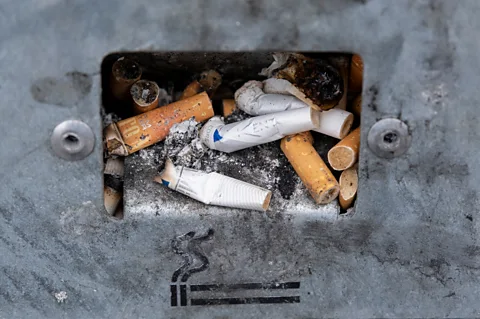In 2017, a group of Swiss scientists published a study disputing one of PMI’s central marketing claims, namely that IQOS is smoke-free because of the lack of combustion or burning of the tobacco leaves.
Instead, the researchers argue that the emissions from heated tobacco devices should still be considered as “smoke” and should fall under indoor smoking bans in the same way as cigarettes. Their study showed that IQOS tobacco reaches around 330C (626F), a finding supported by other studies, while a conventional cigarette reached around 684C (1,263F).
In their subsequent analysis of IQOS emissions, they concluded that the heated tobacco vapour also contained harmful chemicals which stem from pyrolysis – the term for incomplete combustion – and thermogenic degradation, making it more similar to cigarette smoke than the company was claiming. “Smokers and non-smokers need accurate information about toxic compounds released in IQOS smoke,” the scientists wrote.
PMI was quick to respond to the study, sending the authors a letter disputing many of the results. A subsequent analysis by the FDA also warned there were “significant analytical issues” with the study that made it difficult to compare the levels of harmful and potentially harmful compounds from heated tobacco to those from cigarettes. PMI maintains that IQOS heats tobacco but does not burn it.
Other research, however, has examined the type and quantity of toxins present in the vapours produced by heated tobacco.
All three of the tobacco companies we spoke to acknowledge that it would be incorrect to say heated tobacco products are safe or risk free
At the National Technical University of Athens, chemical engineer Efthimios Zervas has spent much of the past decade painstakingly analysing the chemicals present in the fumes of products including IQOS and glo. He describes it as a slow and complex process because the fumes emitted contain many thousands of different chemicals, in combinations that vary greatly from one product to another.
“We try to study as much as we can, but it’s difficult because as soon as we publish our results, this product we’ve been analysing has either been modified or is no longer on the market,” he says. “So you’re constantly playing catch-up with the industry.”
Still, Zervas has drawn a number of conclusions. As with cigarettes, he has found that heated tobacco products release high concentrations of fine particles, capable of penetrating deep into the body. Other studies have identified known toxins present in the gaseous emissions. Indeed, many toxins and carcinogens were present at far lower concentrations in heated tobacco vapours than in fumes from cigarettes. But Zervas has found others, such as carbonyl methylglyoxal, that he says are actually emitted in higher concentrations by heated tobacco products.
“There are toxic products in there, so we cannot say that these devices are safe,” says Zervas.
PMI says that its own research indicates that IQOS does not generate solid particles in the aerosol it emits.
Industry-backed studies have also reported a long list of compounds in the aerosols from heated tobacco – one study by BAT found more than 120 while another detected 205 compounds in the aerosols, including 82 not seen in cigarette smoke. These include compounds that are the result of heating glycerol, which is one of the ingredients in heated tobacco sticks. The WHO has called for more research to evaluate the effect of these compounds on human health when inhaled at the relatively high levels in heated tobacco aerosols.
Meanwhile early studies in animals indicate that there may be some long-term effects of heated tobacco on cardiovascular health and the central nervous system, but these results are yet to be seen in humans.
 Getty Images
Getty ImagesSuch sentiments have been noted by regulators. While the US Food and Drug Administration (FDA) has authorised PMI to market multiple heated tobacco products, it also declared that this “does not mean these products are safe nor FDA approved”. The FDA also says, “There are no safe tobacco products, so those who do not currently use tobacco products, especially young people, should not start.”
All three of the tobacco companies the BBC spoke to acknowledge that it would be incorrect to say heated tobacco products are safe or risk free. But they say research indicates that they provide a way of reducing exposure to harmful compounds if smokers switch from cigarettes to heated tobacco products.
“This fundamental principle underpins the promise that smoke-free products like IQOS hold for advancing global health and further validates PMI’s commitment to a smoke-free future,” says Moira Gilchrist, PMI’s global chief communications officer.
“The majority of risk associated with cigarettes comes from the burning of tobacco and not the nicotine,” says a BAT spokesperson. “glo, while not risk free, does not involve burning tobacco.” Footnotes in their response, however, added that their statement assumes a complete switch from cigarette smoking and notes that their product is addictive and not risk free.